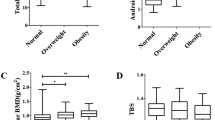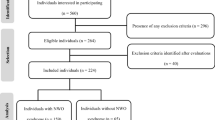Abstract
Background
Overweight youth have greater bone mass than their healthy-weight peers but sustain more fractures. However, it is unclear whether and how excess body fat influences bone quality in youth.
Questions/purposes
We determined whether overweight status correlated with three-dimensional aspects of bone quality influencing bone strength in adolescent and young adult females and males.
Methods
We categorized males (n = 103; mean age, 17 years) and females (n = 85; mean age, 18 years) into healthy-weight and overweight groups. We measured lean mass (LM) and fat mass (FM) with dual-energy x-ray absorptiometry (DXA). We used high-resolution peripheral quantitative CT to assess the distal radius (7% site) and distal tibia (8% site). Bone quality measures included total bone mineral density (Tt.BMD), total area (Tt.Ar), trabecular bone volume fraction (BV/TV), trabecular number (Tb.N), separation (Tb.Sp), and thickness (Tb.Th). We used multiple regression to compare bone quality between healthy-weight and overweight adolescents adjusting for age, ethnicity, limb length, LM, and FM.
Results
Overweight males had higher (10%–21%) Tt.BMD, BV/TV, and Tb.N and lower Tb.Sp at the tibia and lower Tt.Ar at the radius than healthy-weight males. No differences were observed between overweight and healthy-weight females. LM attenuated the differences in bone quality between groups in males while FM negatively predicted Tt.BMD, BV/TV, Tb.N, and Tb.Th.
Conclusions
Our data suggest overweight males have enhanced bone quality compared with healthy-weight males; however, when group differences are interpreted in the context of the mechanostat theory, it appears bone quality of overweight adolescents adapts to LM and not to greater FM.




Similar content being viewed by others
References
Ackerman A, Thornton JC, Wang J, Pierson RN Jr, Horlick M. Sex difference in the effect of puberty on the relationship between fat mass and bone mass in 926 healthy subjects, 6 to 18 years old. Obesity (Silver Spring). 2006;14:819–825.
Augat P, Schorlemmer S. The role of cortical bone and its microstructure in bone strength. Age Ageing. 2006;35(suppl 2):ii27–ii31.
Bailey DA, McKay HA, Mirwald RL, Crocker PR, Faulkner RA. A six-year longitudinal study of the relationship of physical activity to bone mineral accrual in growing children: the University of Saskatchewan bone mineral accrual study. J Bone Miner Res. 1999;14:1672–1679.
Baxter-Jones A, Mirwald RL, McKay HA, Bailey DA. A longitudinal analysis of sex differences in bone mineral accrual in healthy 8–19-year-old boys and girls. Ann Hum Biol. 2003;30:160–175.
Bell J, Rogers VW, Dietz WH, Ogden CL, Schuler C, Popovic T. CDC grand rounds: childhood obesity in the United States. MMWR Morb Mortal Wkly Rep. 2011;60:42–46.
Burrows M, Baxter-Jones A, Mirwald R, Macdonald H, McKay H. Bone mineral accrual across growth in a mixed-ethnic group of children: are Asian children disadvantaged from an early age? Calcif Tissue Int. 2009;84:366–378.
Burrows M, Liu D, McKay H. High-resolution peripheral QCT imaging of bone micro-structure in adolescents. Osteoporosis Int. 2010;21:515–520.
Burrows M, Liu D, Moore S, McKay H. Bone microstructure at the distal tibia provides a strength advantage to males in late puberty: an HR-pQCT study. J Bone Miner Res. 2010;25:1423–1432.
Burrows M, Liu D, Perdios A, Moore S, Mulpuri K, McKay H. Assessing bone microstructure at the distal radius in children and adolescents using HR-pQCT: a methodological pilot study. J Clin Densitom. 2010;13:451–455.
Cao JJ. Effects of obesity on bone metabolism. J Orthop Surg Res. 2011;6:30–36.
Clark EM, Ness AR, Tobias JH. Adipose tissue stimulates bone growth in prepubertal children. J Clin Endocrinol Metab. 2006;91:2534–2541.
Cole TJ, Bellizzi MC, Flegal KM, Dietz WH. Establishing a standard definition for child overweight and obesity worldwide: international survey. BMJ. 2000;320:1240–1243.
Dimitri P, Wales JK, Bishop N. Fat and bone in children: differential effects of obesity on bone size and mass according to fracture history. J Bone Miner Res. 2010;25:527–536.
Ducher G, Bass SL, Naughton GA, Eser P, Telford RD, Daly RM. Overweight children have a greater proportion of fat mass relative to muscle mass in the upper limbs than in the lower limbs: implications for bone strength at the distal forearm. Am J Clin Nutr. 2009;90:1104–1111.
El Hage RP, Courteix D, Benhamou C, Jacob C, Jaffré C. Relative importance of lean and fat mass on bone mineral density in a group of adolescent girls and boys. Eur J Appl Physiol. 2009;105:759–764.
Ellis KJ, Shypailo RJ, Wong WW, Abrams SA. Bone mineral mass in overweight and obese children: diminished or enhanced? Acta Diabetol. 2003;40(suppl 1):S274–S277.
Farr JN, Chen Z, Lisse JR, Lohman TG, Going SB. Relationship of total body fat mass to weight-bearing bone volumetric density, geometry, and strength in young girls. Bone. 2010;46:977–984.
Fricke O, Sumnik Z, Tutlewski B, Stabrey A, Remer T, Schoenau E. Local body composition is associated with gender differences of bone development at the forearm in puberty. Horm Res. 2008;70:105–111.
Frost HM. Bone “mass” and the “mechanostat”: a proposal. Anat Rec. 1987;219:1–9.
Frost HM. Obesity, and bone strength and “mass”: a tutorial based on insights from a new paradigm. Bone. 1997;21:211–214.
Goulding A, Grant AM, Williams SM. Bone and body composition of children and adolescents with repeated forearm fractures. J Bone Miner Res. 2005;20:2090–2096.
Goulding A, Taylor RW, Jones IE, McAuley KA, Manning PJ, Williams SM. Overweight and obese children have low bone mass and area for their weight. Int J Obes Relat Metab Disord. 2000;24:627–632.
Hills AP, Andersen LB, Byrne NM. Physical activity and obesity in children. Br J Sports Med. 2011;45:866–870.
Humphries IR, Hua V, Ban L, Gaskin KJ, Howman-Giles R. Validation of estimates of lean tissue mass made by dual-energy X-ray absorptiometry. Ann NY Acad Sci. 2000;904:104–106.
Janicka A, Wren TA, Sanchez MM, Dorey F, Kim PS, Mittelman SD, Gilsanz V. Fat mass is not beneficial to bone in adolescents and young adults. J Clin Endocrinol Metab. 2007;92:143–147.
Leonard MB, Shults J, Wilson BA, Tershakovec AM, Zemel BS. Obesity during childhood and adolescence augments bone mass and bone dimensions. Am J Clin Nutr. 2004;80:514–523.
Liu D, Burrows M, Egeli D, McKay H. Site specificity of bone architecture between the distal radius and distal tibia in children and adolescents: an HR-pQCT study. Calcif Tissue Int. 2010;87:314–323.
Lochmüller EM, Miller P, Bürklein D, Wehr U, Rambeck W, Eckstein F. In situ femoral dual-energy X-ray absorptiometry related to ash weight, bone size and density, and its relationship with mechanical failure loads of the proximal femur. Osteoporos Int. 2000;11:361–367.
Lorentzon M, Landin K, Mellström D, Ohlsson C. Leptin is a negative independent predictor of areal BMD and cortical bone size in young adult Swedish men. J Bone Miner Res. 2006;21:1871–1878.
Ma H, Turpeinen T, Silvennoinen M, Torvinen S, Rinnankoski-Tuikka R, Kainulainen H, Timonen J, Kujala UM, Rahkila P, Suominen H. Effects of diet-induced obesity and voluntary wheel running on the microstructure of the murine distal femur. Nutr Metab (Lond). 2011;8:1–11.
Macdonald H, Kontulainen S, Petit M, Janssen P, McKay H. Bone strength and its determinants in pre- and early pubertal boys and girls. Bone. 2006;39:598–608.
Macdonald HM, Kontulainen SA, MacKelvie-O’Brien KJ, Petit MA, Janssen P, Khan KM, McKay HA. Maturity- and sex-related changes in tibial bone geometry, strength and bone-muscle strength indices during growth: a 20-month pQCT study. Bone. 2005;36:1003–1011.
MacKelvie KJ, McKay HA, Khan KM, Crocker P. A school-based exercise intervention augments bone mineral accrual in early pubertal girls. J Pediatr. 2001;139:501–508.
Malina RM. Quantification of fat, muscle and bone in man. Clin Orthop Relat Res. 1969;65:9–38.
Manske SL, Macdonald HM, Nishiyama KK, Boyd SK, McKay HA. Clinical tools to evaluate bone strength. Clin Rev Bone Miner Metab. 2010;8:122–134.
McKay HA, Petit MA, Khan KM, Schutz RW. Lifestyle determinants of bone mineral: a comparison between prepubertal Asian- and Caucasian-Canadian boys and girls. Calcif Tissue Int. 2000;66:320–324.
Petit MA, Beck TJ, Shults J, Zemel BS, Foster BJ, Leonard MB. Proximal femur bone geometry is appropriately adapted to lean mass in overweight children and adolescents. Bone. 2005;36:568–576.
Petit MA, McKay HA, MacKelvie KJ, Heinonen A, Khan KM, Beck TJ. A randomized school-based jumping intervention confers site and maturity-specific benefits on bone structural properties in girls: a hip structural analysis study. J Bone Miner Res. 2002;17:363–372.
Pollock NK, Laing EM, Baile CA, Hamrick MW, Hall DB, Lewis RD. Is adiposity advantageous for bone strength? A peripheral quantitative computed tomography study in late adolescent females. Am J Clin Nutr. 2007;86:1530–1538.
Pollock NK, Laing EM, Hamrick MW, Baile CA, Hall DB, Lewis RD. Bone and fat relationships in postadolescent black females: a pQCT study. Osteoporosis Int. 2011;22:655–665.
Rauch F, Bailey DA, Baxter-Jones A, Mirwald R, Faulkner R. The “muscle-bone unit” during the pubertal growth spurt. Bone. 2004;34:771–775.
Rocher E, Chappard C, Jaffre C, Benhamou CL, Courteix D. Bone mineral density in prepubertal obese and control children: relation to body weight, lean mass, and fat mass. J Bone Miner Metab. 2008;26:73–78.
Sayers A, Tobias JH. Fat mass exerts a greater effect on cortical bone mass in girls than boys. J Clin Endocrinol Metab. 2010;95:699–706.
Schoenau E. From mechanostat theory to development of the “functional muscle-bone-unit”. J Musculoskelet Neuronal Interact. 2005;5:232–238.
Sopher AB, Thornton JC, Wang J, Pierson RN Jr, Heymsfield SB, Horlick M. Measurement of percentage of body fat in 411 children and adolescents: a comparison of dual-energy X-ray absorptiometry with a four-compartment model. Pediatrics. 2004;113:1285–1290.
Tanner JM. Foetus into Man: Physical Growth from Conception to Maturity. Cambridge, MA: Harvard University Press; 1978.
Taylor ED, Theim KR, Mirch MC, Ghorbani S, Tanofsky-Kraff M, Adler-Wailes D, Brady S, Reynolds JC, Calis KA, Yanovski JA. Orthopedic complications of overweight in children and adolescents. Pediatrics. 2006;117:2167–2174.
Wang MC, Bachrach LK, Van Loan M, Hudes M, Flegal KM, Crawford PB. The relative contributions of lean tissue mass and fat mass to bone density in young women. Bone. 2005;37:474–481.
Weiler HA, Janzen L, Green K, Grabowski J, Seshia MM, Yuen KC. Percent body fat and bone mass in healthy Canadian females 10 to 19 years of age. Bone. 2000;27:203–207.
Wetzsteon RJ, Petit MA, Macdonald HM, Hughes JM, Beck TJ, McKay HA. Bone structure and volumetric BMD in overweight children: a longitudinal study. J Bone Miner Res. 2008;23:1946–1953.
Wey HE, Binkley TL, Beare TM, Wey CL, Specker BL. Cross-sectional versus longitudinal associations of lean and fat mass with pQCT bone outcomes in children. J Clin Endocrinol Metab. 2011;96:106–114.
Acknowledgments
We thank the many members of the Healthy Bones Research team whose ideas and hard work contributed to the design and implementation of the Healthy Bones studies over the years, especially Kerry MacKelvie-O’Brien, PhD, Moira Petit, PhD, Deetria Egeli, BHSc, and Sarah Moore, MSc. We are blessed with skilled and knowledgeable research staff and acknowledge the key contribution of Danmei Liu, PhD, to the medical imaging of bone and to Douglas Race, MA, and his measurement team for acquisition of anthropometry and other data. Without the ongoing and sustained support of schools in Vancouver and Richmond in British Columbia, which are key partners in this research, we would be unable to conduct our studies. Finally, we owe a huge debt of gratitude to the boys and girls (now young men and women) who participated in the Healthy Bones trials over the last decade.
Author information
Authors and Affiliations
Corresponding author
Additional information
The institution of one or more of the authors (CH, HM, HM) has received, during the study period, funding from the Canadian Institutes of Health Research (MOP-84575).
All ICMJE Conflict of Interest Forms for authors and Clinical Orthopaedics and Related Research editors and board members are on file with the publication and can be viewed on request.
Each author certifies that his or her institution approved the human protocol for this investigation, that all investigations were conducted in conformity with ethical principles of research, and that informed consent for participation in the study was obtained.
This work was performed at the Centre for Hip Health and Mobility, Vancouver Coastal Health Research Institute, Vancouver, BC, Canada.
About this article
Cite this article
Hoy, C.L., Macdonald, H.M. & McKay, H.A. How Does Bone Quality Differ Between Healthy-weight and Overweight Adolescents and Young Adults?. Clin Orthop Relat Res 471, 1214–1225 (2013). https://doi.org/10.1007/s11999-012-2576-0
Published:
Issue Date:
DOI: https://doi.org/10.1007/s11999-012-2576-0




